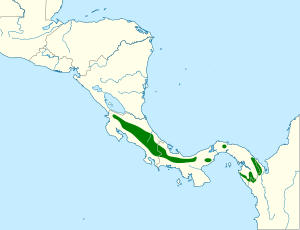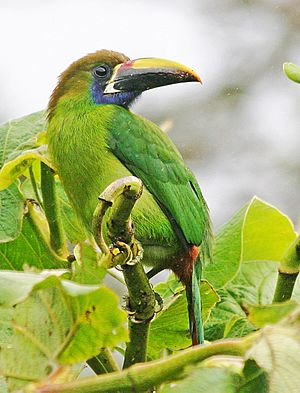Blue-throated toucanet facts for kids
Quick facts for kids Tucano-de-garganta-azul |
|
|---|---|
 |
|
| Conservation status | |
| Scientific classification | |
| Genus: |
Aulacorhynchus
|
| Species: |
caeruleogularis
|
| Subspecies | |
|
See text |
|
 |
|
| Synonyms | |
|
|
The blue-throated toucanet (Aulacorhynchus caeruleogularis) is a super cool bird that belongs to the toucan family. You can find it living in the forests of Costa Rica, Panama, and a small part of northwestern Colombia.
Contents
About This Bird
How Scientists Classify It
For a long time, the blue-throated toucanet was thought to be just one of many types of the emerald toucanet. But in 2008, a group of bird experts called the International Ornithological Committee (IOC) decided that it was special enough to be its own species! Another big bird organization, BirdLife International, agreed.
Later, in 2016, the IOC also decided to combine the violet-throated toucanet with the blue-throated toucanet. So now, the blue-throated toucanet has two main types, or subspecies, that scientists recognize:
- The main type, called A. c. caeruleogularis.
- The "violet-throated toucanet" type, called A. c. cognatus. This one is also sometimes called Nelson's toucanet.
What Does It Look Like?
Like all toucans, the blue-throated toucanet has a really big bill! These birds are about 29 to 37 centimeters (11 to 15 inches) long. They weigh around 120 to 185 grams (4.2 to 6.5 ounces). Both male and female toucanets look similar, but the female is usually a bit smaller and has a shorter bill.
Their bill is mostly black with a bright yellow stripe along the top. It also has a white stripe at its base. The main type of blue-throated toucanet has a reddish-brown patch near the base of its bill, but the A. c. cognatus type does not.
Most of their body feathers are green, just like other toucanets in their group. Their lower face and throat are a deep blue color, which is how they got their name! The feathers under their tail and the underside of their tail are a chestnut (reddish-brown) color. The top of their tail starts green and turns blue towards the end, with chestnut tips on the feathers. Young toucanets are a bit grayer than adults.
Where It Lives
The main type of blue-throated toucanet lives in most of Costa Rica and goes into western Panama. The A. c. cognatus type is found in central and eastern Panama, and even a little bit into Colombia.
These birds usually live in humid montane forests, which are forests on mountains. But you can also find them in more open areas like younger forests, bushy areas, pastures, and even farms. In Costa Rica, they live at heights between 800 and 3,000 meters (2,600 to 9,800 feet) above sea level. In Panama, they are found between 600 and 2,400 meters (2,000 to 7,900 feet) high.
How It Behaves
Moving Around
The blue-throated toucanet does not migrate. This means it stays in the same area all year long and doesn't fly to different places for winter or summer.
Social Life
These toucanets are very social birds! They often hang out together in groups of up to about 10 birds.
What It Eats
The blue-throated toucanet finds its food by picking things off branches while it's perched. It eats a wide variety of things! Its diet includes many different kinds of fruits, lots of insects, and even small animals like birds, eggs, lizards, and snakes.
Family Life
The breeding season for the blue-throated toucanet is from March to August. They make their nests in holes in trees. These holes can be natural, or they might be old holes that woodpeckers made and then left. Their nests can be as high as 27 meters (89 feet) off the ground!
A female toucanet usually lays three or four eggs, but sometimes it can be one to five. Both the male and female take turns sitting on the eggs to keep them warm, but the female does most of the work. The eggs hatch after about 16 days. The young birds are ready to fly out of the nest when they are about 42 to 45 days old.
Sounds It Makes
The main sound the blue-throated toucanet makes is a loud, dry "rrip rrrip rrip rrip" or "curré curré curré." You can often hear this call for minutes at a time! When they fly, their wings make a whirring sound.
Its Status
The IUCN (International Union for Conservation of Nature) has looked at the blue-throated toucanet and decided it is a species of "Least Concern." This means that it is not currently in danger of disappearing. We don't know exactly how many of these birds there are, but their population seems to be stable. There aren't any big, immediate threats to them right now. However, like many animals, they could be affected if their forest homes are destroyed.
See also
 In Spanish: Tucanete gorjiazul para niños
In Spanish: Tucanete gorjiazul para niños



